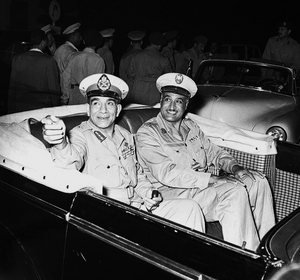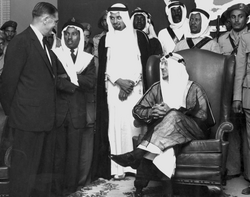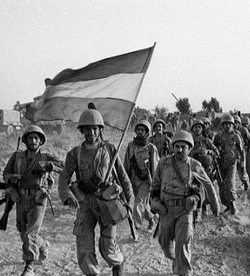Khazi Revolution
| Khazi Revolution Tir Revolution | |||
|---|---|---|---|
| Part of Zorasani unification | |||
 KRRC leader Mustafa al-Kharadji (L) with Ali Sayyad Gharazi following the King's death | |||
| Date | 11 July 1952 - 18 November 1952 (4 months, 7 days) | ||
| Location | |||
| Caused by |
| ||
| Goals | Overthrow of the Abdulkarimite monarchy Unification of Khazestan and Pardaran | ||
| Methods | |||
| Resulted in |
| ||
| Parties to the civil conflict | |||
| Lead figures | |||
| Casualties | |||
| 2,583 protesters and loyalists killed 2,800-4,000 protesters injured | |||
The Khazi Revolution (Badawiyan: ثورة العرفانية; Thawrah al-Kaṣiyyah), also known as the Tir Revolution in Pardaran (Pasdani: انقلاب تیر; Enqelâbe Tir) was a series of events that led to the overthrow of the Abdulkarimite monarchy and the establishment of an interim government led by the Khazi Revolutionary Resistance Command and the unification of Khazestan and Pardaran in December 1952 and the division of the country. The overthrow was aided by a several leftist groups and movements and by a military invasion by neighboring Pardaran.
Opposition to the King escalated with the emergence of the Khazi Revolutionary Resistance Command in 1948 as the most prominent anti-monarchist group. By 1950, the KRRC was receiving significant materiel aid from Pardaran, enabling it expand its bases of operations and its network across Khazestan. In the summer of 1952, food shortages led to bread riots and eventually mass demonstrations against the monarchy, which now began to respond with violent crackdowns. Influenced by the KRRC, the mass protests grew rapdily and spread to every major city in the country, drawing the involvement of numerous leftist groups. Between July and October, the KRRC worked to use its network within the military to under the King's authority, culminating in the Army's declaration of neutrality on November 1. On November 5, in support of the KRRC, Pardaran invaded Khazestan and seized the capital, Faidah on November 10. The following day, the King and most of his family were captured outside the capital and executed. Within hours, the KRRC under Mustafa al-Kharadji proclaimed a provisional government. During this time, significant numbers of royal court members and loyalist army units fled to the north, leading to the proclamation of the Second Kingdom of Khazestan and the country's formal division.
The revolution led to the formation of the Union of Khazestan and Pardaran and is widely considered the first major event of the Arduous Revolution, which would result in a series of major conflicts and political upheveal before directly leading to the unification of Zorasan into the Union of Zorasani Irfanic Republics in 1980. The revolution also proved the viability of Sattarism among Badawiyan anti-monarchist elements, much to the concern of Badawiyan states, who would go on to form the Mubaraz Pact in 1953.
Origins
The Khazi Revolution’s causes can be traced back to the immediate founding of the nation in 1946, through the Treaty of Ashcombe, which dissolved the Etrurian Colonial Empire in wake of the Solarian War. Much like its Badawiyan neighbours, Khazestan was granted independence under the leadership of the most prominent and popular figures, who went on to form monarchies, owing to their prior roles as tribal leaders. Upon its independence, Khazestan came under the rule of Hussein ibn Majid, the leader of the Al-Suwaydi tribe. This form of government was received poorly among most educated Khazis who failed to recognise the legitimacy of the Al-Suwaydi tribe as national leaders.
This lack of legitimacy fed into the general failure of the monarchy to develop a fully coherent national identity. Like most post-Solarian War monarchies, there was an aversion to fostering a Badawiyan identity, through fear that doing so would undermine their reigns or limit any possible patriotism with the monarch at the head. As historian Said Khan noted, “the Post-Solarian Zorasani monarchs worked tirelessly to evoke identities of their nations around them and their families, to be Khazi was to be a subject of King Hussein.” Not only did this fail to cement national solidarity or unity, owing to the previously mentioned lack of legitimacy in the eyes of powerful circles, it left open space for the influence of Pardarian Pan-Zorasanism. The other disadvantage was that until 1946, none of the Post-Solarian states had existed historically, for the region being dominated by successive Pardarian empires and dynasties for over a millennia. Their borders were defined by Etrurian colonial maps, as well as the provincial boundaries of the pre-colonial Gorsanid Empire, denying any nationalism a geographical anchor from which to emerge.
In Khazestan’s case, these weaknesses were crippling for the monarchy. The Al-Suwaydi tribe had poor relations with its neighbours and rivals in Khazestan, while many ordinary Khazis saw the King and his family as over opulent, wealthy and corrupt, even before they assumed power in 1946. Khazestan’s historic role as the “second pillar to Pardaran within its empires” led to an innate and close socio-political and cultural relationship with its larger neighbour. The shared trials and suffering under Etruria also bridged the two states on an emotional level. The weakenesses would further fuel general disconent over a series of other grieviences, over food shortages, economic failure and social injustice.
Economic stagnation
Khazestan suffered considerable damage during the Solarian War, being a major theatre of conflict between Etruria and CN forces between 1944 and 1946. The new kingdom, although possessing oil and gas fields discovered by the Etrurians in the 1920s and 1930s, failed to rebuild infrastructure adequately or evenly. Despite most cities being physically rebuilt by 1952, many homes and businesses were housed in rudimentary and poorly constructed buildings. The monarchy also focused much of its resources and revenues on rebuilding and modernising regions within the historic territory of the Al-Suwaydi tribe.
The historian Said Khan described it, “the towns on Al-Suwaydi land saw electricity, gas and roads. To Khazis they were the glittering images of the future, easily seen from the war torn and decrepit regions they lived in.” Despite making Faidah, the capital of Khazestan in 1946, the northern city of Gharaf had the largest population, the Kingdom’s failure to restore electricity or introduce running water despite promises established Gharaf as a hotbed for republican agitation by the late 1940s.
The devastation left millions unemployed, while the Etrurian efforts to urbanise the population in the early 20th century had left the monarchy a significant urban population whose livelihoods were left destroyed. By 1952, unemployment had reached 39% of the national labour force. Rural areas faired better from the Solarian War, but many regions were left isolated through the destruction of roads, rail and bridges. The urban population’s destitution and joblessness led to the rise of radical groups, the two most prominent being the Khazi Revolutionary Resistance Command and the Khazi Section of the Worker’s Internationale.
Between 1946 and 1952, the Kingdom rebuilt damaged oil facilities with Euclean assistance. However, rather than utilise the growing revenues from oil, the monarchy would utilise the capital for personal use. It is estimated that between 1946 and 1952, the Al-Suwaydi family seized up to 44% of oil revenues, what remained was then invested into tribal lands. The immense wealth and cronyism of the monarchy led to immediate economic stagnation, financial bottlenecks and the continued devastation in other parts of the country.
Social injustice
King Hussein
Insecurity and chaos created after the Solarian War led to the rise of Hussein ibn Majid, a prominent tribal leader who had links to various guerrilla groups during the Solarian War. Prior to the war, he had played a significant role as a mediator between the Etrurian colonial authorities and other tribal leaders. In the pursuit of viable post-independence government, the Community of Nations highly influenced by Estmere and Werania, who had opened communications with Al-Majid in 1944, recognised his influence and placed him as head of the short-lived Khazi provisional government. Al-Majid immediately proclaimed himself King over an absolute monarchy.
There were few but consequential social, economic, and political laws and reforms introduced during his reign and a number of these reforms led to public discontent which provided the circumstances for the Khazi Revolution. Particularly controversial was the replacement of several Irfanic laws with Euclean ones and the legal establishment of the Al-Suwaydi tribe over all others. The introduction of a "royal tax" on souk merchants, the replacement of Irfanic clothing with traditional tribal garments and the limiting of Irfanic clerical influence alarmed both traditional and religious peasants and middle-class merchants alike.
The king's personal greed, opulence and corruption became widely known by 1952, with his lavishing of immense sums of money on banquets, weddings and parties for his children and relatives roiling many across all society. The king's rejection of any need for popular input on governmental matters or national decision making also alienated the moderate constitutional movement. Hussein's inherent mistrust of the general populace would later fuel the heavy handedness and violence during crackdowns on protests, becoming more reliant on extravagantly paid soldiers in the Royal Army and Royal Guard to quash dissent.

